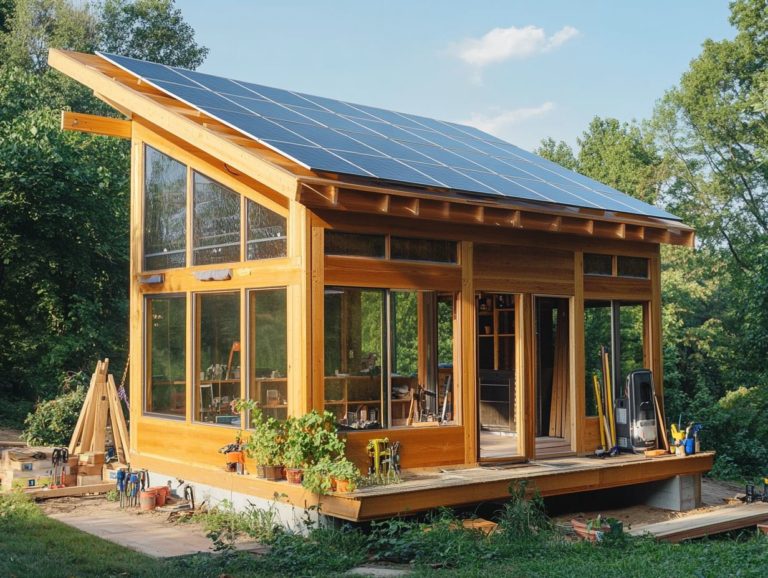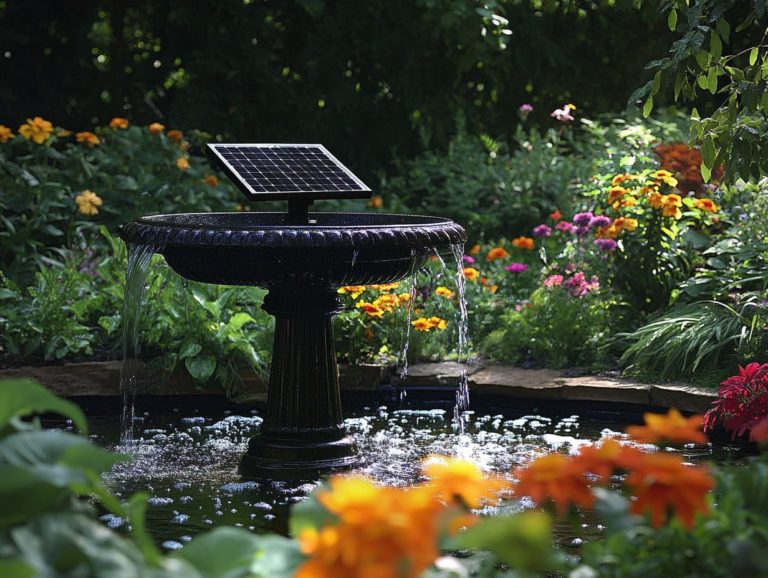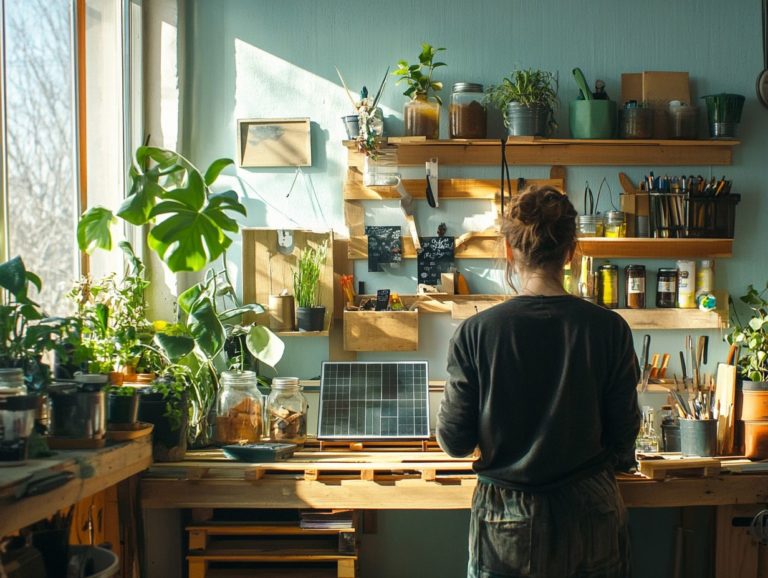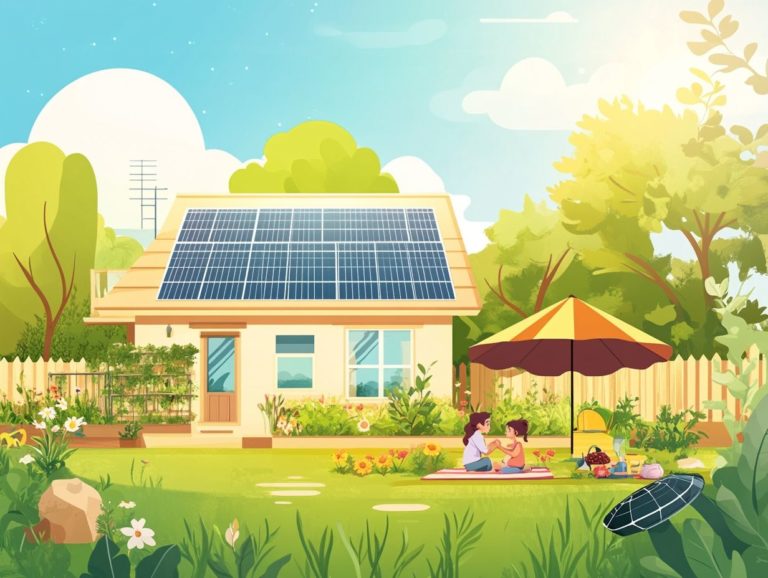5 Practical DIY Solutions for Energy Efficiency
In today s world, energy efficiency has transcended mere trend status; it’s now an essential strategy for reducing your carbon footprint while saving money. Adding sustainable features to your home can further enhance these benefits.
This article offers five practical DIY energy-saving solutions that will empower you to transform your home into an energy-saving powerhouse. From ensuring proper insulation and adopting energy-efficient lighting to harnessing natural light and optimizing your appliances, you ll discover straightforward strategies that are accessible to everyone.
Furthermore, we ll delve into the financial advantages of these changes, explore renewable energy options, and outline government incentives that can amplify your savings.
Prepare to uncover how simple adjustments can lead to a more sustainable and financially savvy home!
Contents
- Key Takeaways:
- 1. Insulate Your Home Properly
- 2. Switch to Energy-Efficient Light Bulbs
- 3. Install a Programmable Thermostat
- 4. Use Natural Light and Ventilation
- 5. Reduce Energy Usage in the Kitchen and Laundry Room
- How Can Energy Efficiency Save You Money?
- Frequently Asked Questions
- What are 5 practical DIY solutions for energy conservation and efficiency?
- How can replacing old light bulbs with LED lighting improve energy efficiency?
- What is weather stripping and how can it improve energy efficiency and home improvement?
- How do power strips contribute to energy efficiency?
- Why is adding attic insulation important for energy efficiency?
- Can planting trees really improve energy efficiency through smart landscaping?
Key Takeaways:

1. Insulate Your Home Properly
Proper insulation is crucial for enhancing energy efficiency in your home. It significantly cuts down on heating and cooling costs by maintaining a consistent indoor temperature and minimizing energy wastage.
Investing in effective insulation materials like fiberglass, cellulose, and spray foam insulation helps create a comfortable living environment while contributing to energy conservation.
Getting an energy audit means checking how much energy your home uses. This helps you find areas that need improvement, guiding your decisions on attic insulation, weather stripping, and other necessary upgrades.
Fiberglass insulation is a popular choice thanks to its cost-effectiveness and ease of installation. However, you’ll need protective gear to handle it safely. Elizabeth Mendenhall from the National Association of Realtors suggests considering various insulation options to maximize energy efficiency.
Alternatively, cellulose insulation, made from recycled paper, offers excellent soundproofing but may be more susceptible to moisture-related issues if not installed correctly. Spray foam insulation stands out for its ability to create an airtight seal, making it ideal for hard-to-reach areas, but be prepared for a higher price tag compared to its counterparts.
To achieve maximum effectiveness, ensure your attic is well-insulated to prevent heat loss in winter and keep your home cool in summer. Walls benefit from using different types of insulation.
Regular energy audits are essential! They help you find thermal leaks and prioritize your insulation projects, keeping your home cozy while maximizing energy efficiency.
2. Switch to Energy-Efficient Light Bulbs
Switching to energy-efficient light bulbs, especially LED lighting, can significantly impact your utility bills while championing energy conservation in both your home and business. These advanced bulbs consume far less electricity than traditional incandescent options, providing not only a longer lifespan but also remarkable energy savings.
In fact, you can save up to 80% energy by using LEDs, resulting in lower monthly costs and a welcome reduction in your overall carbon footprint. With a lifespan that can stretch up to 25,000 hours or more, these bulbs outlast their conventional counterparts, enhancing your cost-effectiveness by cutting down on replacement frequency.
By pairing energy-efficient appliances with LED lighting, you can amplify your energy savings, resulting in a notable reduction in waste and exhaust. Even small adjustments, like swapping out a few bulbs, can yield substantial long-term benefits for both the environment and your wallet.
3. Install a Programmable Thermostat
Installing a programmable thermostat is a savvy home upgrade that gives you the power to manage your energy usage effectively. Ultimately, this can save you a lot of money while helping the planet by slashing your heating and cooling costs through automated scheduling and precise temperature control. This technology enhances your comfort and encourages mindful energy consumption, ensuring your heating and cooling systems operate only when they’re truly needed.
With features like remote access via smartphone apps, you can effortlessly adjust your home’s temperature from almost anywhere. This makes it a breeze to return to a warm, inviting space after a long day. You can program energy-saving modes for specific times, such as reducing heating during work hours or raising cooling overnight, resulting in substantial savings.
Regularly updating your schedule is crucial to fully reap these benefits according to seasonal changes. Ensure your HVAC system undergoes routine maintenance, including filter changes and professional inspections, to keep everything running efficiently.
4. Use Natural Light and Ventilation
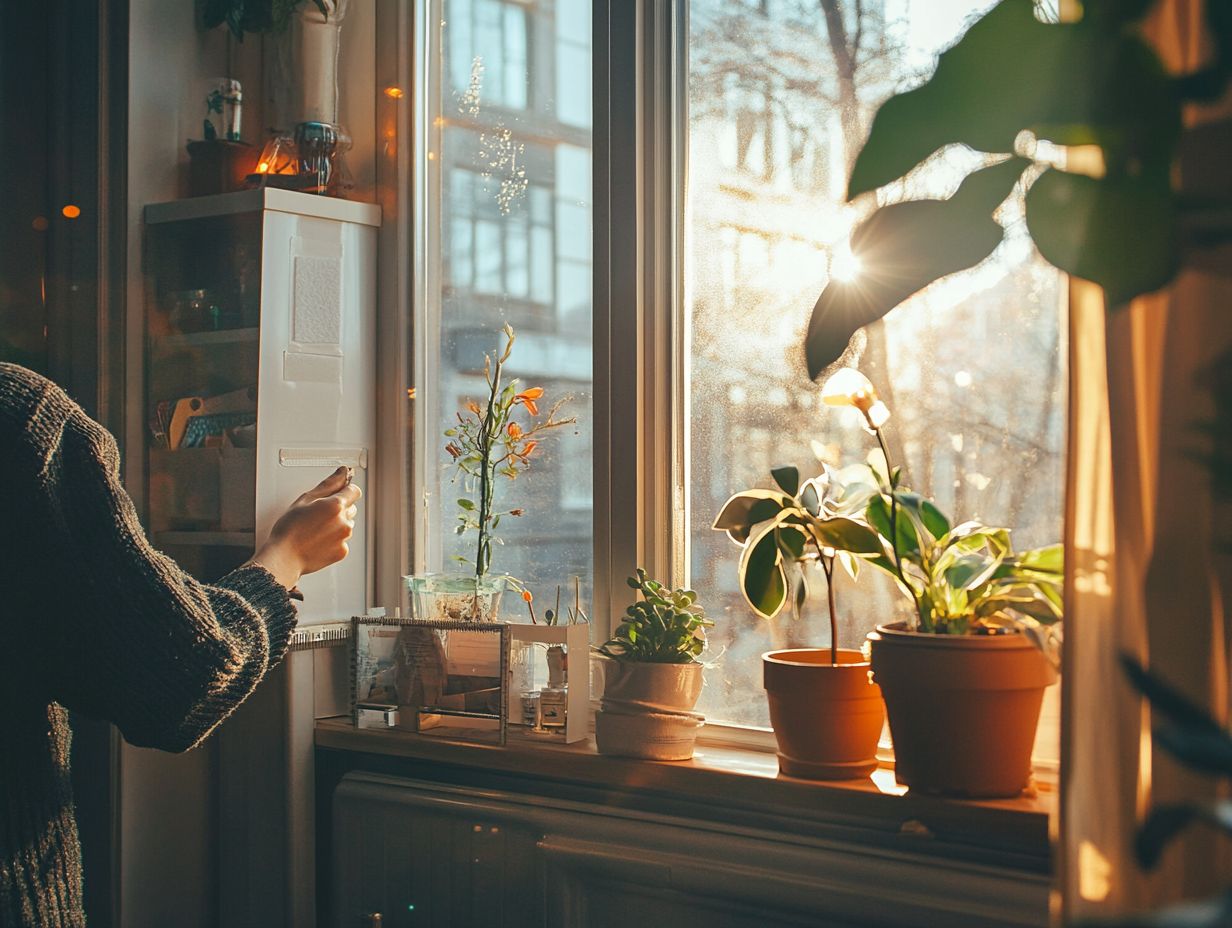
Utilizing natural light and fresh air is a fantastic approach to enhancing energy efficiency in your home. Smart landscaping and thoughtful window placement can help you make the most out of these natural resources. By doing so, you can reduce your reliance on artificial lighting and air conditioning, ultimately slashing those pesky utility bills. Implementing smart landscaping techniques, like strategically planting deciduous trees, allows you to enjoy abundant natural light while providing shade that keeps your home cool.
Consider rethinking your window placement to optimize sunlight exposure throughout the day while improving the flow of fresh air through your home. For example, larger windows on the south-facing side capture generous amounts of light, and incorporating reflective surfaces indoors can help bounce that light deeper into your space. Adding features like skylights can elevate illumination without sacrificing your privacy.
On the exterior, thoughtful landscaping elements such as well-placed shrubbery and trees can block harsh winds or filter out strong sunlight, significantly enhancing both comfort and energy savings. Redesigning your rooms with an open layout can further promote better airflow, making your spaces feel more inviting and reducing your reliance on heating or cooling systems.
5. Reduce Energy Usage in the Kitchen and Laundry Room
Reducing energy usage in your kitchen and laundry room can save you a lot of money while helping the planet. Opting for energy-efficient appliances and water-saving fixtures can make a significant impact. Choosing ENERGY STAR certified appliances and water-saving fixtures allows you to minimize your environmental footprint and lower those utility bills.
For example, using a high-efficiency dishwasher not only leaves your dishes sparkling clean but also uses less water and energy per load compared to older models. Similarly, swapping out traditional washing machines for front-loading versions can slash water usage by up to 50%, all while delivering faster drying times.
Beyond selecting the right appliances, consider strategies like running your dishwasher and washing machine only when they’re fully loaded to maximize energy savings. Utilizing cold water for laundry can also be just as effective at cleaning your clothes while conserving the energy typically spent on heating water.
Make these changes today to save money and create a sustainable home for tomorrow!
How Can Energy Efficiency Save You Money?
Energy efficiency has the power to significantly reduce your utility bills, delivering both immediate and long-term financial advantages through smart energy conservation practices. These practices lower the costs of managing your home s energy use. Companies like Direct Energy and Long Home Products offer excellent resources for boosting your home energy management.
By embracing a range of strategies like upgrading to energy-efficient appliances and fine-tuning your heating and cooling systems, you can greatly reduce your monthly expenses while doing your part for a more sustainable environment.
Take, for example, a family in California who replaced their outdated HVAC system with a high-efficiency model. Imagine the savings! They enjoyed a remarkable 30% reduction in their summer cooling costs. Similarly, a homeowner in Texas installed ENERGY STAR-rated windows and reported savings exceeding $1,000 annually, all thanks to decreased heating and cooling needs. For those looking to maximize their energy efficiency, learning how to conduct your own energy audit can provide valuable insights.
Incorporating smart thermostats into your home allows you to manage your energy consumption with greater precision, potentially saving you up to 15% on heating and cooling bills. By investing in these upgrades, you not only witness a significant drop in your bills but also contribute meaningfully to energy conservation efforts in your community.
What Are the Benefits of Using Renewable Energy Sources?
Utilizing renewable energy sources, like installing solar panels, brings a wealth of benefits your way. Imagine slashing your utility bills while making a meaningful contribution to energy efficiency and conservation efforts. These sustainable solutions offer a cleaner alternative to fossil fuels, leading to a reduction in greenhouse gas emissions and a more resilient energy system.
As a homeowner, you might also want to consider other options such as wind turbines, geothermal systems, and tankless water heaters to elevate your energy independence even further. By integrating these renewable sources into your home systems, you not only diminish your carbon footprint but can also reap long-term savings through government incentives and reduced energy costs, as suggested by the Department of Energy. For more ideas, check out these top energy-saving tips for homeowners.
Embracing renewable energy and sustainable features allows you to adopt a more sustainable lifestyle, enhancing your property s value while decreasing reliance on conventional, non-renewable energy sources. Ultimately, by adopting renewable technologies, you are not only contributing to a healthier environment but also promoting economic stability and energy security for the future.
How Can You Monitor Your Energy Usage?
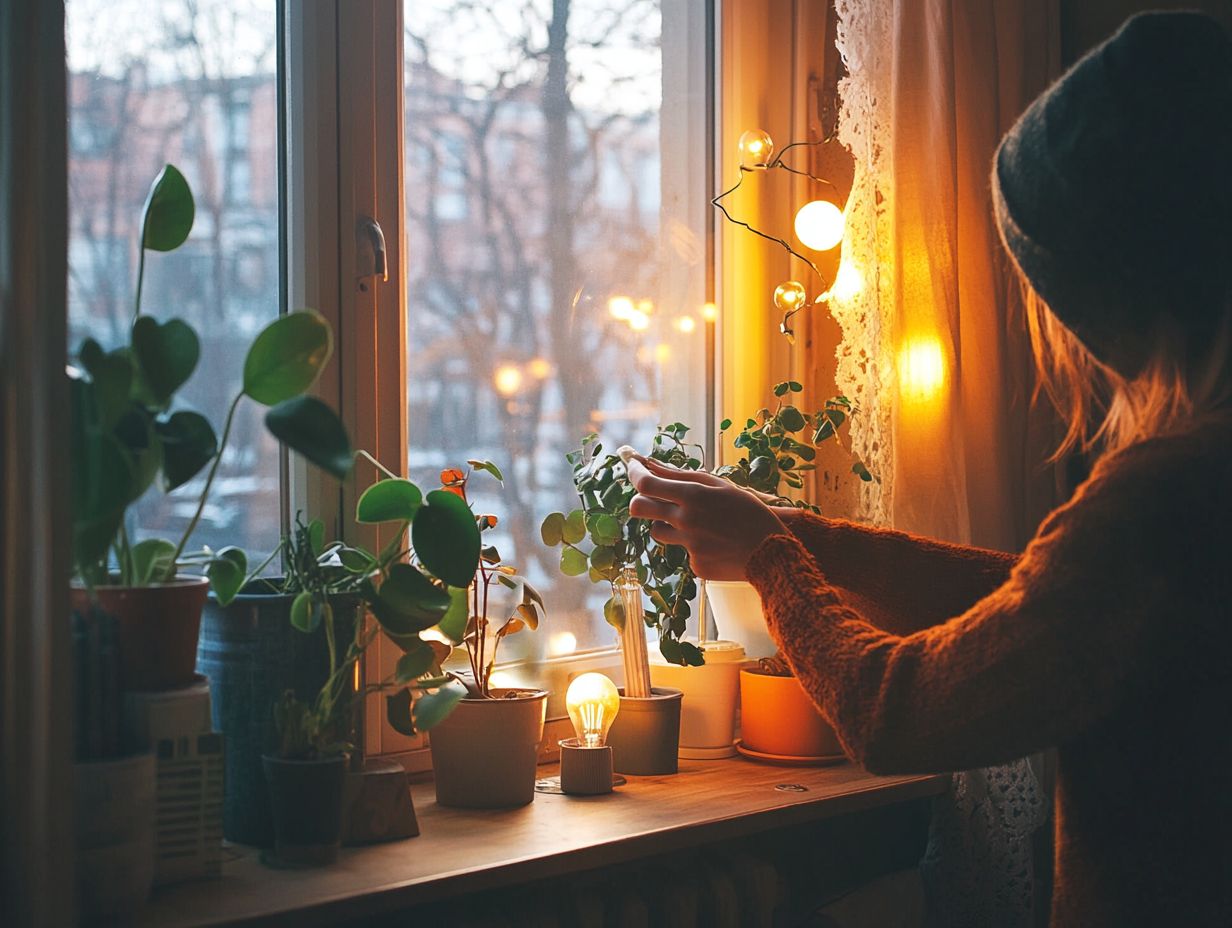
Monitoring your energy usage is essential for effective home energy management. It enables you to pinpoint areas ripe for improvement and implement energy-saving strategies. By embracing smart home technologies and conducting regular energy audits, you can gain valuable insights into your household’s energy consumption patterns.
This allows you to take proactive steps toward reducing waste and improving energy efficiency. There are various tools at your disposal to assist you on this journey, with smart meters being a particularly popular choice. These devices track your energy use in real-time, allowing you to adjust your habits accordingly.
For a more comprehensive solution, consider systems that help manage your energy use, which allow you to analyze trends and optimize settings for your appliances. Be mindful of the 5 common myths about energy efficiency, as using intelligent power strips can help you manage energy usage more effectively.
Once you complete an energy audit, understanding the results becomes imperative. It’s not just about recognizing where most of your energy is being spent; it’s about leveraging that information to prioritize upgrades or behavioral changes that can lead to significant savings in your energy costs. Exploring options like the top 5 energy-efficient lighting options can further support these efforts and help you implement DIY energy-saving tips.
What Are the Common Energy Wasters in a Home?
Common energy wasters in your home can significantly inflate your utility bills and undermine your energy conservation efforts, making it crucial for you to identify and address these inefficiencies. Frequent offenders include outdated HVAC systems, inefficient appliances, and inadequate insulation all of which can be evaluated through a thorough energy audit. Upgrading to energy-efficient appliances and improving insulation, such as adding fiberglass insulation, can make a significant difference.
It’s easy to overlook the energy consumed by devices left plugged in when not in use, like chargers, televisions, and computers. Upgrading to Energy Star-rated appliances can dramatically reduce your energy consumption, offering a more sustainable alternative. For more tips, consider following 5 ways to improve your home’s efficiency today. Regular maintenance, such as cleaning or replacing air filters, can enhance system efficiency. Additionally, using programmable thermostats can help manage heating and cooling costs more effectively.
Additionally, implementing practices like sealing leaks, adding cellulose insulation, and utilizing programmable thermostats will help you further optimize your energy use. For more tips, check out these 5 ways to reduce energy waste at home.
By conducting routine energy audits, you can pinpoint specific energy wasters, enabling you to make informed decisions about upgrades and habits that lead to significant cost savings and a lower environmental impact. For more insights, check out maximizing energy efficiency techniques. Consider incorporating smart landscaping practices, such as planting deciduous trees, to enhance energy efficiency further.
What Are the Government Incentives for Energy Efficiency?
Government incentives for energy efficiency, including tax credits and rebates for renewable energy sources, are designed to encourage you to adopt more sustainable practices and technologies. By capitalizing on these financial incentives, you can significantly offset the upfront costs of energy-efficient upgrades, making them not only more accessible but also more affordable. Installing water-saving fixtures and tankless water heaters can also qualify for certain rebates.
A variety of programs are available to you at both federal and local levels, all aimed at promoting energy efficiency. At the federal level, the Investment Tax Credit (ITC) enables you to receive a substantial percentage back on the costs of solar panel installations. Additionally, local programs may offer further rebates for energy-efficient appliances or home improvements, such as enhanced insulation. Energy-efficient lighting and HVAC maintenance can also be part of these programs.
To qualify for these benefits, you’ll typically need to meet specific criteria, which may include the types of upgrades you make or your income thresholds. The potential savings are impressive, often reaching thousands of dollars annually on your energy bills, all while contributing to a cleaner environment. Notable organizations like the Department of Energy and energy service companies like Direct Energy often provide guidance on these programs.
Expert opinions from professionals such as Charles Roberts and Elizabeth Mendenhall from the National Association of Realtors, along with insights from Business Insider and Terra Home Performance, highlight the importance of energy efficiency in today’s homes.
Frequently Asked Questions
What are 5 practical DIY solutions for energy conservation and efficiency?

1. Replace old light bulbs with energy-efficient LED bulbs. 2. Install weather stripping around doors and windows to prevent drafts. 3. Use power strips to easily turn off electronics when not in use. 4. Add insulation to your attic and walls to keep your home better insulated. 5. Plant trees or shrubs strategically to provide natural shade for your home.
How can replacing old light bulbs with LED lighting improve energy efficiency?
LED bulbs use 75-80% less energy than traditional incandescent bulbs, making them a cost-effective choice for energy efficiency. They also last much longer, reducing the frequency of replacements and saving even more energy.
What is weather stripping and how can it improve energy efficiency and home improvement?
Weather stripping is a flexible material that is placed around doors and windows to seal any gaps and prevent air leaks. This helps to maintain a consistent temperature in your home, reducing the need for heating or cooling and saving energy.
How do power strips contribute to energy efficiency?
Many electronics and appliances continue to use energy even when turned off, known as “phantom power.” By using power strips, you can easily turn off multiple devices at once, eliminating this wasted energy and reducing your electricity bill.
Why is adding attic insulation important for energy efficiency?
Insulation acts as a barrier to prevent heat from escaping your home in the winter and entering in the summer. By adding insulation to your attic and walls, you can reduce the amount of energy needed to maintain a comfortable temperature indoors.
Can planting trees really improve energy efficiency through smart landscaping?
Yes, planting trees or shrubs strategically around your home can provide natural shade, reducing the amount of direct sunlight and heat that enters your home. This can help to keep your home cooler in the summer, reducing the need for air conditioning and saving energy.


